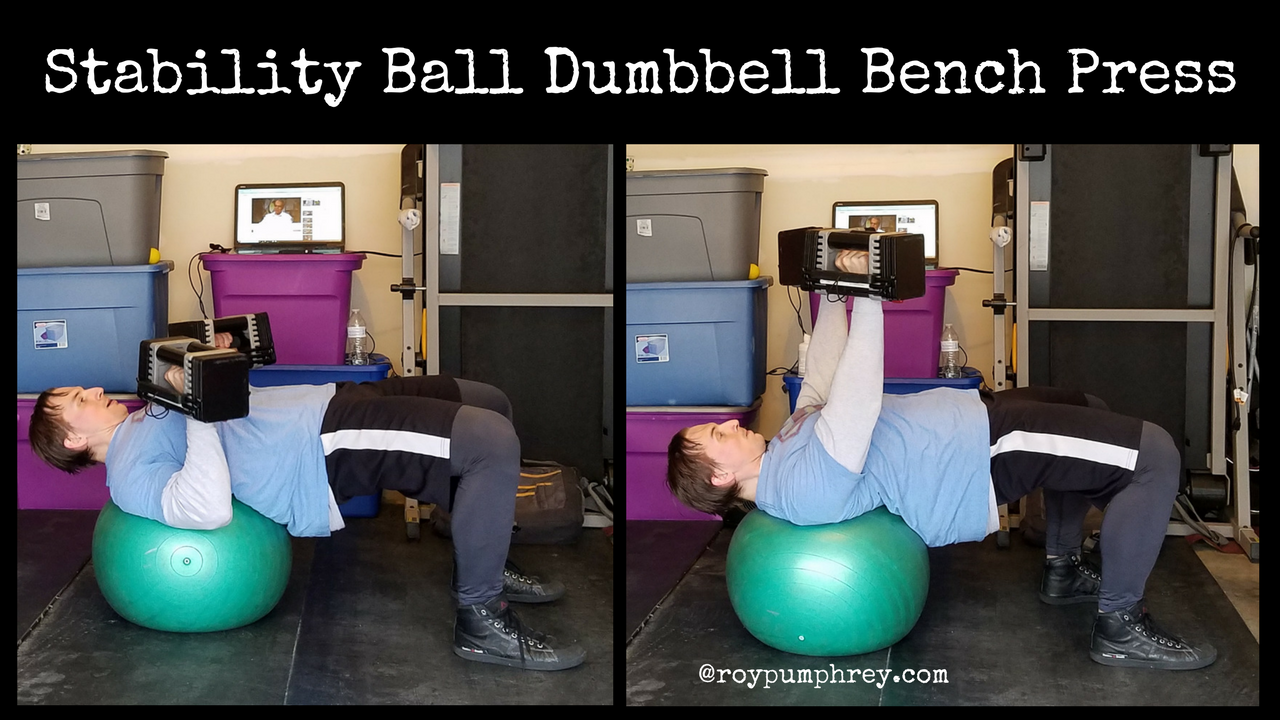
Yeah, I know I rag on wobble stuff all the time.
I even did Masters Work on unstable surfaces.
So I can say with a fairly high degree of certainty:
If you’re trying to get really strong,
This Exercise Should Probably NOT be One of Your Primary Strength Exercises.
But for accessory stuff, it ain’t all that bad.
Here’s The Deal:
We’ll start with the bad <—ALWAYS start with the bad. Get up and “eat the frog”
Using an unstable surface instantly makes you weaker.
“It has been established that there is a significantly lower peak isometric force and rate of force development during resistance exercises under unstable as compared to stable conditions. In addition, the power output was compromised when exercises were performed on unstable surfaces.”- Zemkova
The short of it is; your primary movers, in this case your pecs and delts spend more time “stabilizing” (think Joint Centration) the shoulder joint than creating force to press the weight.
See muscles only know:
Length and Tension
That’s it, they don’t get confused either.
So if the primary movers spend more tension/ contraction/ force to tighten the joint up they can’t spend that tension/ muscle action/ contraction creating force to move the joint.
The Result:
Less FORCE (F=Ma) production in the line of action.
Lift less weight, get less strong.
But Using the Ball Increases the Activity of the “Stabilizers”?
Well, the jury is actually still out on that one, but the research isn’t promising.
Short story is,
The Size Principle.
The size principle states that motor units will be recruited in order of size from smallest to largest depending upon the intensity. – Jessee
The body goes up the chain and activates the largest motor units, just think muscles, needed, yet no larger for a task.
Yeah, the stabilizers come on to provide the timing mechanism for the joint rhythm (what stabilizers do) but not to help lift more weight.
“stabilizer muscles can be defined as muscles that contribute to joint stiffness by co-contraction and show an early onset of activation in response to perturbation via either a feed-forward or a feedback control mechanism.”- Sangwan, Green and Taylor
Basically the “stabilizers” (rotator cuff, etc) are far too small to be activated or stressed more because the surface is unstable rather than stable.
They’re turned on regardless once the force applied to the joint is large enough.
Remember, primary mover force production is decreased on an unstable surface because the primary movers are needed to help stabilize the joint more than on a stable surface.
So, that alone tells me, that the unstable surface does nothing to improve the strength of the stabilizers. in and of itself.
*Obviously, if you from 70 to 80lbs your body will respond by gaining strength in ALL of the muscles need. So yes, lifting more weight would make the stabilizers stronger, just not the instability of a swiss ball.
So Why the Hell Would You Want to Do Stability Ball Dumbbell Bench?
Cause sometimes it ain’t always about how much you can lift. <—-Who are we kidding right? Jk, but not really.
Occasionally you need something that’s “challenging” but less “demanding”.
Like during rehab period or deload week, when you would want to get some muscle activation and a training effect without over stressing the muscles and nervous system.
“Some of the characteristics of IRT exercises that are not conducive to optimal strength or power training for athletes, may be favorable for rehabilitation. The instability‐induced deficits in force compared to traditional stable RT exercises, which dampen the strength training stimuli in trained individuals, can be of sufficient intensity for a recuperating muscle. While, these lower external forces exert less, but healthy stress on a more injury‐susceptible joint, the less dramatic changes or even increases in trunk and limb muscle activation provide greater stabilizing functions to protect recovering muscles and articulations.”- Behm, Colado
During a set of Stability Ball Dumbbell Bench Press you need to get tight, stay tight and your chest, shoulders, triceps, even glutes and legs will get fatigued at the end of the set.
But you’re obviously using less weight so its (assuming your not a SlopZilla) less demanding on the CNS and joints.
You’ll get a nice pump in the muscles without having to hoist up the same weights AND you’ll possibly improve technique because you gotta turn everything on to get into and stay in the proper position.
How I Use The Stability Ball Dumbbell Bench Press:
Typically I’ll program these as an accessory movement after any heavy stuff towards the end of a workout and use one of these three approaches except when I don’t.
High Freaking Reps:
Sets of 15 are “low rep” when using the Stability ball.
Usually its more like 20-50 reps a set.
This is a brutally long time under tension, fills the working muscles with blood and burns like fire.
These sets are typically taken to, or just shy of, failure.
Timed Sets:
Pure brutality….
Take a weight that is 30-50% of your 1RM and press it for a minute.
You can rest as often as you want, but you need to hold the bells at arm’s length for “rest” and you can’t put them down until the minute is up NO MATTER WHAT.
The goal is to get to the point where you’re constantly pressing the bells through the entire minute.
Rehab:
Any time my shoulder gets banged up and doesn’t like traditional dumbbell bench I’ll use these for about 3 weeks to help get some stimulation of that pattern without loading the tissues too much.
Usually the three-week wave goes something like:
Wk1: 3-5 sets of 10 @ 35-50% <–yes, this is super easy.
Wk2: 3 sets of 10-15 @ 60-70% <–should still be pretty easy
Wk3: 5 sets to failure @ 60-80% <—-increasing the load about 5% each set.
Keep in mind these weights are adjusted down from the flat bench.
So they’re pretty light but I still get a good contraction, activation and “feel” through the pressing muscles.
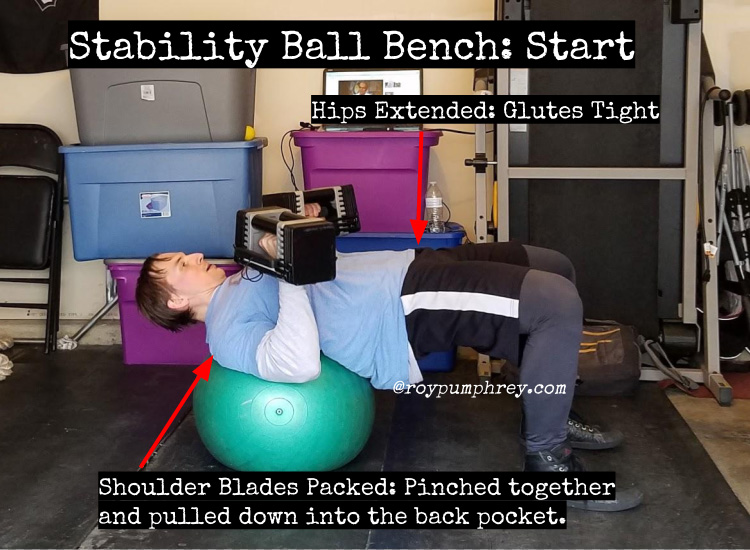
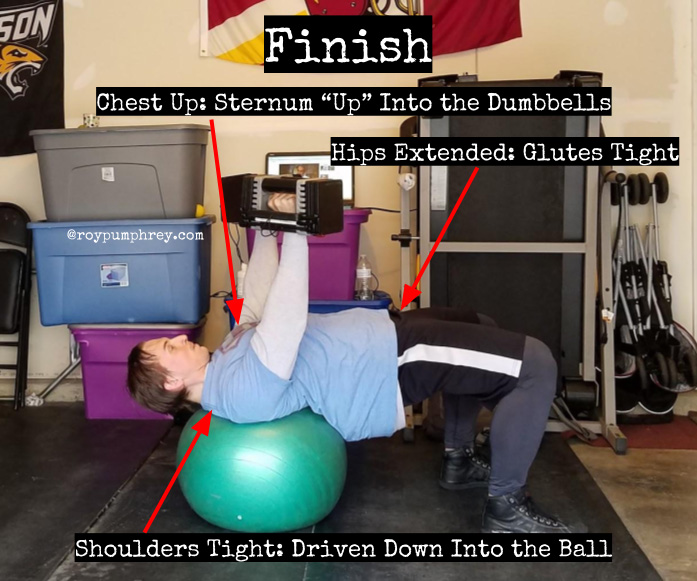
Checklist:
- Set up like ANY OTHER BENCH PRESS.
- Ball under the shoulders.
- Shoulders (packed) pinched together and pulled into the back pockets.
- Hips pressed into full extension (glutes on) feet flat and “rooted” into the floor.
Bro Tips:
- Don’t sag your hips around the ball. Drive your feet down, squeeze your butt hard and keep the hips up, tight and still the WHOLE LIFT.
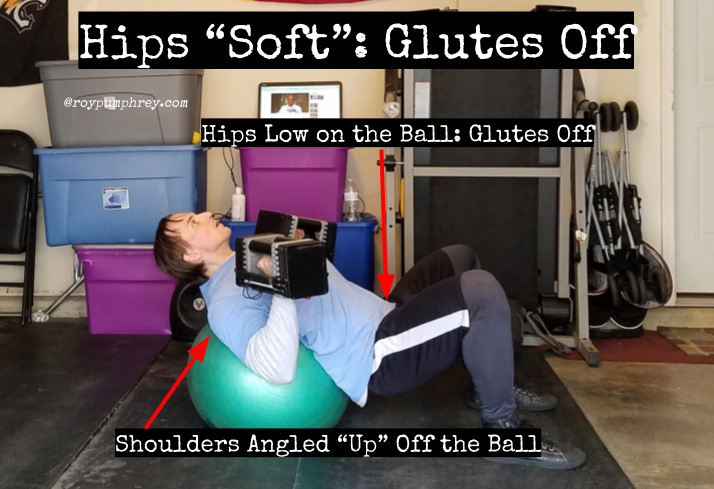
- Head on the ball or off? I prefer off, if you have a big enough ball and you want the head supported? I guess its fine, can’t see why not.
- Think about pressing the shoulders down INTO the ball to press the weight.
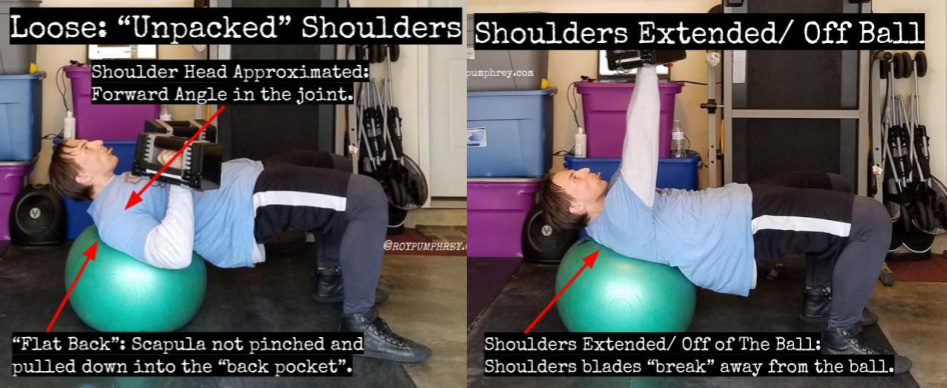



[…] Much like what happens when you add an instability to an exercise; […]